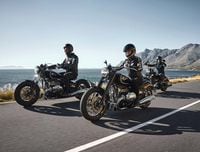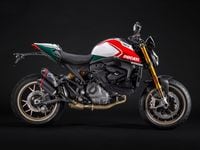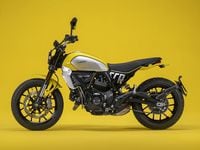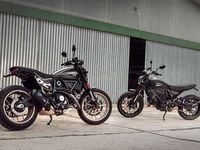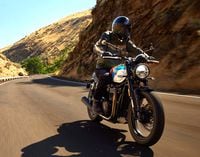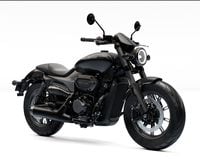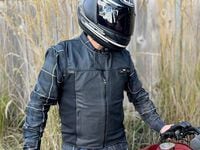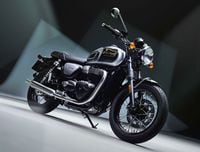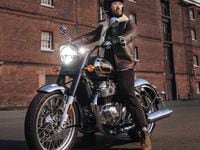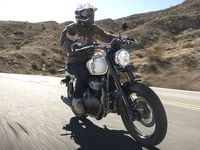This article was originally published in the August 2003 issue of Motorcycle Cruiser.
As much as existing owners might wish, it doesn’t make good business sense for a motorcycle manufacturer to let its models, even successful ones, age gracefully forever. You need to revisit and improve them regularly to compete, even in the cruiser arena. Eventually, you must take a step forward if you want to keep the attention of the new-bike buyer, especially when almost all your competitors (Suzuki is the exception) have introduced new or improved models in the same class.
As much as existing owners might wish, it doesn’t make good business sense for a motorcycle manufacturer to let its models, even successful ones, age gracefully forever. You need to revisit and improve them regularly to compete, even in the cruiser arena. Eventually, you must take a step forward if you want to keep the attention of the new-bike buyer, especially when almost all your competitors (Suzuki is the exception) have introduced new or improved models in the same class.
So after a hugely successful five-year run with few changes, Yamaha's flagship Road Star V-twin series has evolved for '04, acquiring the 1670cc displacement of the Warrior, cast wheels with tubeless tires, better brakes, improved ergonomics and a handful of smaller changes. The result is visually and functionally similar to the original, but more powerful and comfortable.
When the Warrior (which uses the same basic air-cooled engine design, with four valves per cylinder operated by pushrods) was introduced for '02, it was widely anticipated that the Road Star would get the same 2mm wider bores and other power boosts. After all, why not make a change that gives you more appeal and reduces your part-number count and machining needs? Along with that 68cc additional displacement (which puts it over the 100-cubic-inch mark), the '04 Star also gets more compression, short-skirt pistons, dual plugs, longer-duration cams, shorter rockers with less inertia in stouter rocker boxes, thicker cylinder fins to improve cooling and a bigger, restyled, freer-breathing airbox. We expected the Warrior's EFI to be part of the package, but customers wanted the adjustability of the single 40mm carb, which remains.
The 1670’s first gear is taller and closer to second than the 1602’s, but overall ratios are lower. The first-second ratio jump is thus much less noticeable. The various changes allow the new engine to rev higher on top, and the rev limiter does its thing less abruptly. The lower ratios dovetail well with the increased revs up top. The clutch spring is burlier. A narrower, stronger belt drives an improved rear-wheel pulley that matches the new cast wheels.
At the seat of your pants, these changes translate into better power from right off idle to past where the rev limiter used to cut in. The difference is not huge, but it is certainly noticeable. Yamaha claims 18 and 15 percent boosts for horsepower and torque peaks, respectively. You can feel the added muscle coming off the line, and the bike passes more aggressively on the highway than the smaller, taller-geared 1600 model. You can ride faster with a reserve of acceleration. The initial getaway is smoother with the taller low gear. A bit more force is needed to pull the clutch lever, but the lever itself is wider and more comfortable. Shifting remains smooth but positive. The air-cooled engine is a bit cantankerous when cold and takes a few minutes to get to a happy operating temperature. The left-side choke knob for the 40mm carb must be deployed for cold starts.
The seat in your pants will appreciate the wider, more deeply padded saddle. Though it’s a teensy bit farther off the road, the rider’s perch is ultra roomy and shaped so that you can slide around to shift your position. The XV1700’s rider seat is 1.6-inches wider than the XV1600’s, which was already more than ample. However, we still want better padding; this arrangement gets a bit firm after 90 minutes or so. Passengers appreciate the additional attention to their accommodations and reckon they are more relaxing. The back-seater still gets footpegs, not floorboards.
A reconfigured one-piece handlebar riser/mount moves the bar closer to the rider and creates a position that is comfortable and manageable when making full-lock turns or riding at 70 mph. The bar’s bend puts the handgrips low enough to position you so that the effect of windblast is rarely an issue at highway speeds. The bar also includes new bar-end weights to soften vibration. With no balancing mechanism, the 48-degree V-twin does shake a bit at high rpm, though less than we expected. Floating floorboards, which have new rubber inserts, isolate your feet from the shakes. Vibration, though present, thus becomes a very minor issue.
We were less impressed with ride quality. Except for lengthening the swingarm, Yamaha has not revised the suspension, which has fallen behind the other new entry in the class, Kawasaki's 1600, which has impressive suspension control and adjustable damping. The 1670cc Road Star's somewhat soft, lightly damped suspension is satisfactory over small bumps, but as the hits get larger and sharper, the suspension can't keep up. The reduction in unsprung weight may have improved the ride fractionally, but when riding on roads with large rolling bumps or potholes, the bike frequently feels unsettled. You won't have any complaints on smoother roads, however.
Though the wheelbase is a quarter-inch longer, the rake remains 32 degrees. The Road Star’s light, manageable low-speed steering is still here, complemented by the new handlebar arrangement. Handling and steering at all speeds are neutral and predictable, though the bike has a tendency to straighten up if you brake while cornering. One of the photographers we worked with wanted us to do some charges through a stream crossing the road, and the tires worked well in the wet. However, as with the original Road Star, ground clearance while leaned over is modest, making it easy to drag the floorboards before the tires give any hint of getting loose.
The good traction pays off while braking, though. Both wheels have gotten better brakes. Up front, the dual 11.7-inch rotors are pinched by one-piece calipers lifted from the R1 sportbike (and the Warrior), with aluminum pistons and sintered pads from the R6 sporter. These changes combine to provide pleasing power and controllable, ultra-linear stops with modest pressure at the lever (which is wider). The rear pedal is easy to cover, and the brake is controllable, even on slippery pavement.
The 1700 is easily mistaken for the original 1600. The classic lines and touches have the same flavor and offer the same profile. The major tip-off to its identity is the 1700’s nine-spoke, 16-inch cast wheels, painted a sort of pewter with polished rim sections. You might also spot the clear lenses on the turn signals (which have amber bulbs) with their new mounts and similarly styled LED taillight, which is set closer to the rear fender. The cylinders and engine cases are painted black on the 1700, which alters its appearance somewhat and helps obscure some of the ugly plumbing for the clean-air-induction system at the front and left side of the cylinder bases. This is one of the eye-troubling details of the Star. Another one that draws remarks is the chrome nacelle around the shallow speedometer that sweeps forward around the front of the tank and then abruptly stops. You almost expect a tag saying, “To be continued.” But overall, the new Road Star is a handsome piece with the same classic American style and presence of the original.
Yamaha deliberately kept changes down to a minimum so that the vast majority of aftermarket accessories and parts, including exhaust systems, would bolt right on. That also reduced the amount of new tooling required to get the production line rolling, and enabled Yamaha to hold the price. The white version (base color) we tested is $10,999, the same as the ’03 1600. A couple hundred bucks more gets you the red/black two-tone, and for an extra $800, you can have the Midnight version with more chrome, seat studs and an all-black paint job. (You have to hand it to Yamaha for finding a way to make people pay more for almost-basic black.)
Though we hadn’t heard anybody wondering when the Road Star was going to be updated, we are certain that anybody considering rolling one into his garage will find even more reasons to do so with the 1700. Unless you just have to have wire wheels and tube-type tires that can blow out (if you hurry, your dealer will still have some 1600s, perhaps discounted), the 1700 offers the same thing, just a little stronger and better all the way around. Since the price is the same, there is no good reason not to live large.
So you own and love an original Road Star, but this annoying improved version has made you anxious by offering something better and possibly lowering your trade-in value at the same time. Should you jump to the new saddle? It depends on the value of a dollar (or several thousand) to you, but I'd wait for Yamaha to do something with the suspension, at least. Demo-riding a new Star could be good or bad. You can feel the difference, even though it's not huge, and if you still feel it when you're riding your old one, it's going to be hard to resist and could cost you. But if the memory of the difference fades, you're home free. —Art Friedman
At first glance, I was a bit underwhelmed by Yamaha's latest reiteration of the Road Star—you need a microscope to discern any real changes. But when the bike was in motion, I could fully appreciate the upgrades—the power boost is instantly noticeable (hey, it's about time) and handling is pleasantly compliant, with minimal steering inputs required. The ergos nearly swallow me up, though, but then I am on the shorter side of the growth charts. It's a necessary and welcome improvement on the original Yamaha, especially at the price, but I was expecting a little more for the 21st century. —Andrew Cherney










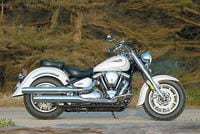
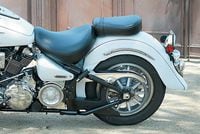
/cloudfront-us-east-1.images.arcpublishing.com/octane/SU6BNQGMZFFCMRSHYF5B4KZJ4Y.jpg)
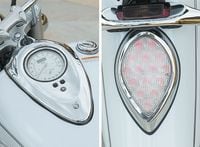
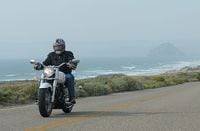
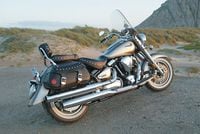
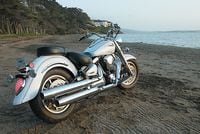
/cloudfront-us-east-1.images.arcpublishing.com/octane/H6Z2IC7WYRBXZNQS4MI3SZ5KPQ.jpg)
/cloudfront-us-east-1.images.arcpublishing.com/octane/IWO5T5PBT5E4HFQ5GK47H5YXR4.jpg)
/cloudfront-us-east-1.images.arcpublishing.com/octane/OQVCJOABCFC5NBEF2KIGRCV3XA.jpg)
/cloudfront-us-east-1.images.arcpublishing.com/octane/F3O2DGLA4ZBDJGNVV6T2IUTWK4.jpg)
/cloudfront-us-east-1.images.arcpublishing.com/octane/ZXYQE3MHLFDSPKNGWL7ER5WJ4U.jpg)
/cloudfront-us-east-1.images.arcpublishing.com/octane/RDF24VM7WVCOBPIR3V3R4KS63U.jpg)
/cloudfront-us-east-1.images.arcpublishing.com/octane/W7RSIBFISNHJLIJESSWTEBTZRQ.jpg)
/cloudfront-us-east-1.images.arcpublishing.com/octane/AERA26ENRNBW3K324YWCPEXYKM.jpg)
/cloudfront-us-east-1.images.arcpublishing.com/octane/YWX3YX7QBBHFXFDMEEEKRG4XJE.jpg)
/cloudfront-us-east-1.images.arcpublishing.com/octane/I7OKI53SZNDOBD2QPXV5VW4AR4.jpg)
/cloudfront-us-east-1.images.arcpublishing.com/octane/IH52EK3ZYZEDRD3HI3QAYOQOQY.jpg)
/cloudfront-us-east-1.images.arcpublishing.com/octane/K2FSAN7OWNAXRJBY32DMVINA44.jpg)
/cloudfront-us-east-1.images.arcpublishing.com/octane/G4XK7JL24FCUTKLZWUFVXOSOGE.jpg)
/cloudfront-us-east-1.images.arcpublishing.com/octane/JJNXVAC27ZCDDCMTHTQZTHO55Y.jpg)
